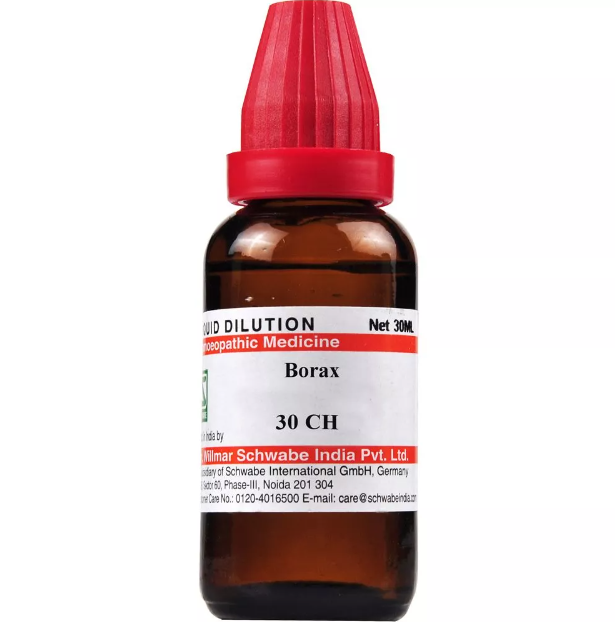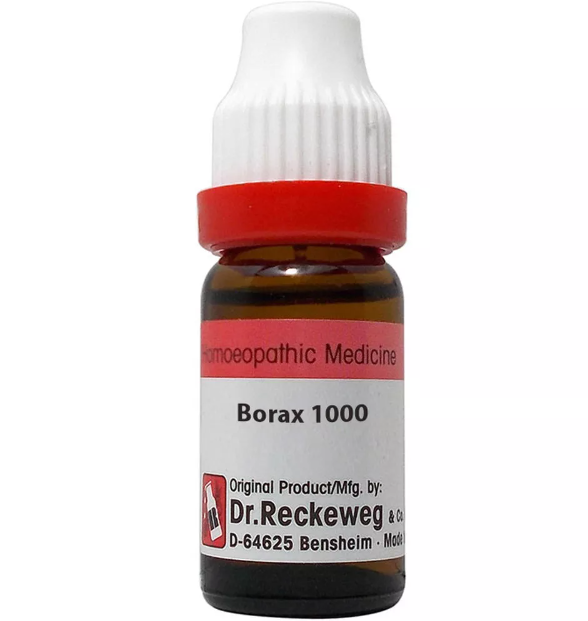BORAX VENETA 3x, 6C, 12C, 30C, 200C, 1M, 10M USES AND SYMPTOMS
 Borax Veneta induces gastrointestinal irritation, resulting in symptoms such as salivation, nausea, vomiting, colic, diarrhea, and even collapse. Additionally, it may lead to albuminuria (presence of albumin in urine), casts in urine, and vesical spasm. Overdosing can cause delirium, visual changes, hematuria (presence of blood in urine), and skin eruptions. Notably, there’s a dread of downward motion associated with many complaints, and the peculiar nervous symptoms it induces are characteristic, particularly in children. It’s also valued in cases of epilepsy and aphthous ulceration of mucous membranes.
Borax Veneta induces gastrointestinal irritation, resulting in symptoms such as salivation, nausea, vomiting, colic, diarrhea, and even collapse. Additionally, it may lead to albuminuria (presence of albumin in urine), casts in urine, and vesical spasm. Overdosing can cause delirium, visual changes, hematuria (presence of blood in urine), and skin eruptions. Notably, there’s a dread of downward motion associated with many complaints, and the peculiar nervous symptoms it induces are characteristic, particularly in children. It’s also valued in cases of epilepsy and aphthous ulceration of mucous membranes.
Mind: Extreme anxiety, particularly triggered by downward motion such as being carried downstairs or laid down. Patients may exhibit an anxious expression during such motions, with a tendency to startle and throw up their hands as if afraid of falling. They are excessively nervous, easily frightened, and sensitive to sudden noises, with a pronounced fear of thunder.
Head: Headaches accompanied by nausea and trembling of the whole body. Tangled hair unable to be separated (like in plica polonica).
Eyes: Lashes turning inward (entropion). Bright wave visions. Inflamed eyelids, lids cutting against the eyeball (blepharitis).
Ears: Very sensitive to slight noises, less disturbed by louder ones.
Nose: Red nose in young women. Swollen and shiny swelling with throbbing sensation. Tip swollen and ulcerated. Dry crusts.
Face: Pale, earthy complexion with a suffering expression. Swollen face with pimples on the nose and lips. Sensation of cobwebs on the face.
Mouth: Aphthous ulcers. White fungus-like growth (candidiasis). Hot and tender mouth; ulcers bleed on touch and eating. Painful gum-boil. Crying during nursing. Bitter taste, taste of “cellar mould.”
Stomach and Abdomen: Distention after eating; vomiting. Gastralgia related to uterine disturbance. Pain as if diarrhea would result.
Stool: Loose, pappy, offensive stools in children. Offensive diarrhea preceded by colic; mucous stools with aphthous sore mouth.
Urinary: Hot, smarting pain in the orifice. Pungent smell. Child afraid to urinate, screams before urinating. Small red particles on the diaper.
Female: Labor-like pains with frequent eructations (belching), galactorrhea (abnormal lactation), pain in the opposite breast while nursing, leucorrhea resembling egg whites with a sensation of warm water flowing, early and profuse menses with griping pain, nausea, and stomach pain extending to the lower back, membranous dysmenorrhea, sterility, and pruritus vulvae (itching of the external female genitalia) and eczema.
Respiratory: Hacking and violent cough with expectoration having a mouldy taste and smell, stitches in the chest on inspiration and coughing, coughing with a mouldy taste and mouldy-smelling breath, pleurodynia (pain affecting the muscles between the ribs and the chest wall), worse in the upper part of the right chest, difficulty breathing while lying down, which forces the individual to jump up and catch their breath, causing pain on the right side, and becoming short of breath while ascending stairs.
Extremities: Sensation of cobwebs on hands. Itching in finger joints and hands. Throbbing pain in thumb tip. Sole stitches. Heel pain. Burning pain in great toe; inflammation of toe balls. Eczema of toes and fingers with nail loss.
Sleep: Voluptuous dreams. Insomnia due to heat, especially in the head. Cries out in sleep as if frightened.
Modalities: Worse with downward motion, noise, smoking, warm weather, after menses. Better with pressure, in the evening, in cold weather.
Relationships: Acetic acid, vinegar, and wine are incompatible. Antidotes: Chamomilla, Coffea. Compare: Calcarea carbonica, Bryonia, Sanicula, Sulphuric acid.
Dose: First to third trituration. In skin diseases, its use may need to be continued for several weeks. It can also be used locally in cases of pruritus pudendi. Additionally, a piece of Borax, the size of a pea, dissolved in the mouth can help restore the voice in cases of sudden hoarseness due to cold, rendering the voice silvery and clear for a short duration.
SYMPTOMS OF BORAX VENETA
Mind:
Extreme anxiety, particularly related to downward motion.
Fear of falling, with physical reactions when laid down.
Excessive nervousness and sensitivity to loud noises.
Fright from sudden noises like thunder or gun retorts.
Head:
Headaches accompanied by nausea and trembling.
Tangled hair tips resembling plica polonica.
Eyes:
Inward turning of lashes.
Visions of bright waves.
Eyelid inflammation causing cutting sensation against eyeball.
Ears:
High sensitivity to even slight noises.
Nose:
Redness, swelling, and dry crusts.
Tip swelling and ulceration.
Face:
Pale, earthy complexion with an expression of suffering.
Swollen face with pimples, sensation of cobwebs.
Mouth:
Aphthae, candidiasis, bleeding ulcers.
Bitter taste resembling “cellar mould.”
Stomach and Abdomen:
Distention, vomiting after eating.
Gastralgia linked to uterine disturbance.
Stool:
Loose, offensive stools with mucous and aphthous mouth ulcers.
Urinary:
Hot, smarting pain with pungent smell.
Fearful urination with screaming.
Female:
Labor-like pains with frequent eructations.
Galactorrhea, menstrual issues, pruritus vulvae.
Respiratory:
Hacking cough with mouldy taste and smell.
Chest stitches, difficulty breathing lying down.
Extremities:
Sensation of cobwebs, itching.
Throbbing pain, stitches, inflammation, eczema.
Sleep:
Voluptuous dreams, insomnia from head heat.
Skin:
Psoriasis, erysipelas, itching, suppuration, herpes.
Modalities:
Worse from downward motion, noise, smoking, warm weather, post-menses.
Better from pressure, evening, cold weather.
Relationships:
Incompatible with acetic acid, vinegar, and wine.
Antidotes include Chamomilla and Coffea.
Comparable to Calcarea, Bryonia, Sanicula, Sulphuric acid.
Dosage:
First to third trituration, continued use for skin diseases, effective locally in pruritus pudendi.
selection of the potency
Individualization:
- Homeopathy is based on the principle of treating the individual, not just the disease. The unique symptoms and characteristics of the person are crucial in determining the most suitable potency.
Intensity of Symptoms:
- The intensity of the symptoms guides the choice of potency. If the symptoms are intense and acute, a lower potency (e.g., 6C, 30C) might be considered. For chronic conditions with less intensity, higher potencies (e.g., 200C, 1M) may be appropriate.
Sensitivity of the Patient:
- Some individuals are more sensitive to homeopathic remedies, while others may require higher potencies. The practitioner considers the patient’s sensitivity when selecting the potency.
Acute vs. Chronic Conditions:
- Lower potencies are often used for acute conditions, while higher potencies may be considered for chronic or long-standing issues.
Previous Response to Potencies:
- The patient’s response to previous homeopathic treatments helps guide the choice of potency. If a particular potency has been effective in the past, it may be repeated or adjusted as needed.
Vital Force and Susceptibility:
- Homeopathy views illness as a disturbance in the vital force. The practitioner assesses the patient’s overall vitality and susceptibility to determine the appropriate potency.
Aggravation or Amelioration:
- The direction of the symptom response (aggravation or amelioration) after taking a remedy can influence the choice of potency.
Miasmatic Considerations:
- In classical homeopathy, the concept of miasms (inherited disease tendencies) is considered. The practitioner take this into account when selecting the potency.
Practitioner Experience:
- The experience and preference of the homeopathic practitioner play a role. Some practitioners may have success with certain potencies based on their clinical experience.
SAFETY INFORMATION
- Do not exceed the recommended dose by physician
- Keep out of the reach of children
- Store in a cool dry place away from direct sunlight
- Maintain half an hour gap between food/drink/any other medicines and homoeopathic medicine
- Avoid any strong smell in the mouth while taking medicine e.g. camphor, garlic, onion, coffee, hing
Medicine images use for reference only selection of homeopathic medicine depends on the individual’s specific symptoms and overall constitution. Moreover, homeopathy is a holistic system of medicine that treats the individual as a whole. In addition to addressing the physical symptoms, it takes into account the emotional and mental state of the person. Consequently, it’s crucial to consult with a qualified homeopathic practitioner for personalized treatment.
The information provided on this website is intended solely for educational purposes. Always seek the advice of your physician or other qualified health provider.
